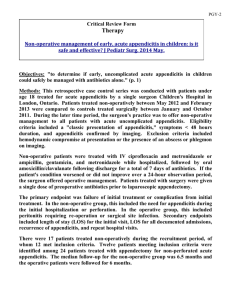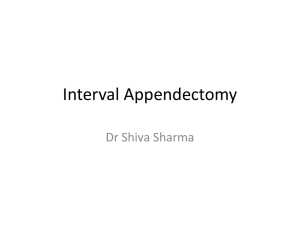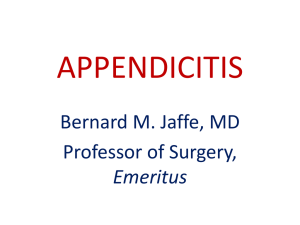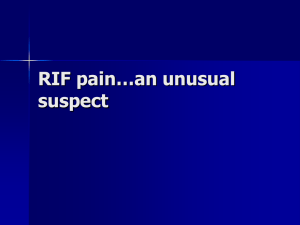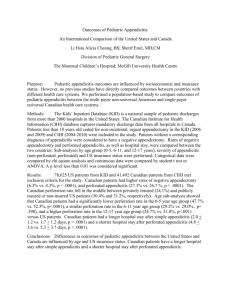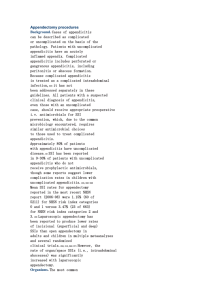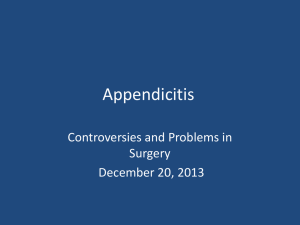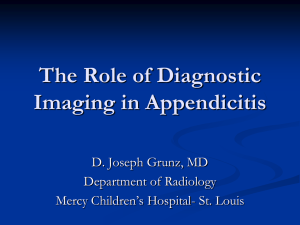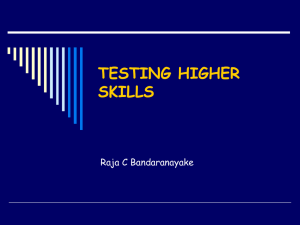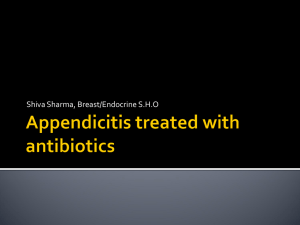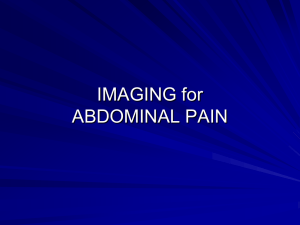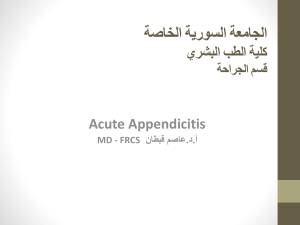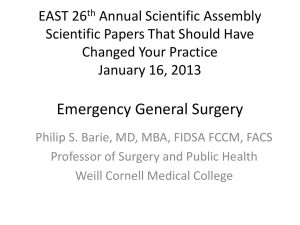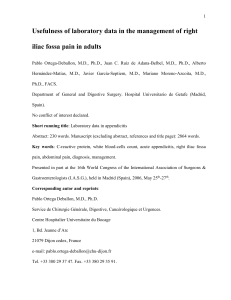Guide
advertisement
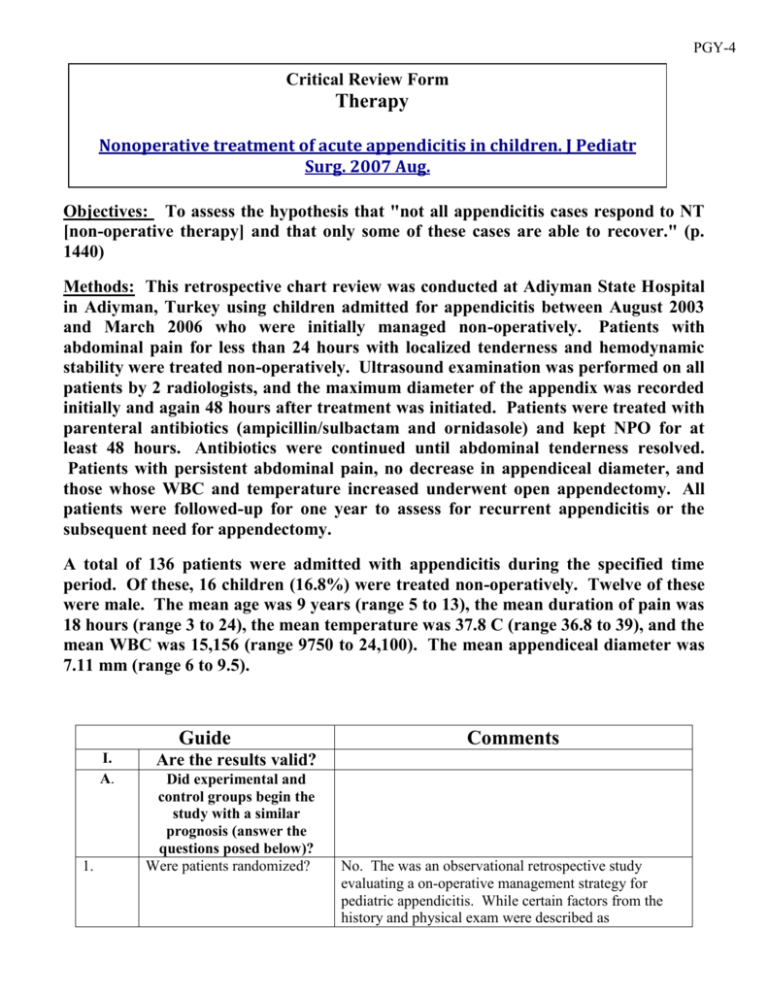
PGY-4 Critical Review Form Therapy Nonoperative treatment of acute appendicitis in children. J Pediatr Surg. 2007 Aug. Objectives: To assess the hypothesis that "not all appendicitis cases respond to NT [non-operative therapy] and that only some of these cases are able to recover." (p. 1440) Methods: This retrospective chart review was conducted at Adiyman State Hospital in Adiyman, Turkey using children admitted for appendicitis between August 2003 and March 2006 who were initially managed non-operatively. Patients with abdominal pain for less than 24 hours with localized tenderness and hemodynamic stability were treated non-operatively. Ultrasound examination was performed on all patients by 2 radiologists, and the maximum diameter of the appendix was recorded initially and again 48 hours after treatment was initiated. Patients were treated with parenteral antibiotics (ampicillin/sulbactam and ornidasole) and kept NPO for at least 48 hours. Antibiotics were continued until abdominal tenderness resolved. Patients with persistent abdominal pain, no decrease in appendiceal diameter, and those whose WBC and temperature increased underwent open appendectomy. All patients were followed-up for one year to assess for recurrent appendicitis or the subsequent need for appendectomy. A total of 136 patients were admitted with appendicitis during the specified time period. Of these, 16 children (16.8%) were treated non-operatively. Twelve of these were male. The mean age was 9 years (range 5 to 13), the mean duration of pain was 18 hours (range 3 to 24), the mean temperature was 37.8 C (range 36.8 to 39), and the mean WBC was 15,156 (range 9750 to 24,100). The mean appendiceal diameter was 7.11 mm (range 6 to 9.5). Guide I. A. 1. Comments Are the results valid? Did experimental and control groups begin the study with a similar prognosis (answer the questions posed below)? Were patients randomized? No. The was an observational retrospective study evaluating a on-operative management strategy for pediatric appendicitis. While certain factors from the history and physical exam were described as determining if non-operative treatment was undertaken (pain < 24 hours, localized tenderness, hemodynamic stability), it is unclear if this protocol was strictly followed. There was no control arm for comparison. Was randomization concealed N/A (blinded)? 2. 3. Were patients analyzed in the groups to which they were randomized? 4. B. Yes. All patients selected for initial non-operative management were assessed, regardless of whether they eventually required surgical appendectomy. There was no control for comparison. Were patients in the treatment N/A. There was no control arm for this study and control groups similar with respect to known prognostic factors? Did experimental and control groups retain a similar prognosis after the study started (answer the questions posed below)? 1. Were patients aware of group allocation? 2. Were clinicians aware of group allocation? 3. Were outcome assessors aware of group allocation? 4. Was follow-up complete? II. 1. Yes. This was a single arm retrospective study of patients undergoing non-operative management of appendicitis. All participants were aware of the decision to attempt non-operative management. Yes. This was a single arm retrospective study of patients undergoing non-operative management of appendicitis. All participants were aware of the decision to attempt non-operative management. Yes. This was a single arm retrospective study of patients undergoing non-operative management of appendicitis. All participants were aware of the decision to attempt non-operative management. Reportedly yes. The authors state that patients were followed up for one year. The method of follow-up (clinic visit, telephone, chart review) was not described. As a result it is unclear if patients requiring appendectomy during the one-year follow-up could have been missed. What are the results (answer the questions posed below)? How large was the treatment effect? The mean appendiceal diameter went from 7.11 ± 1.01 mm (range 6 to 9.5) initially to 4.64 ± 0.82 mm (range 3.6 to 6.8) 48 hours after treatment initiation (p < 0.0001). The mean number of days until abdominal tenderness resolved was 5 (range 4 to 7). 2. How precise was the estimate of the treatment effect? III. One patient failed non-operative management and required appendectomy after one day of antibiotics. An additional 2 patients developed recurrent appendicitis within one year and required appendectomy. The initial failure rate on nonoperative management was therefore 6.3% (95% CI 1.1% to 28%) and the 1-year failure rate was 19% (95% CI 6.6% to 43%). See above. This was small study with wide confidence intervals (one-year failure rate 6.6% to 43%). How can I apply the results to patient care (answer the questions posed below)? 1. Were the study patients similar to my patient? 2. Were all clinically important outcomes considered? 3. Are the likely treatment benefits worth the potential harm and costs? Yes. These were pediatric patients with acute appendicitis diagnosed by ultrasound. While this study was conducted in Turkey, the pathophysiology and management of pediatric appendicitis would be expected to be similar to patients in our Children's Hospital. No. This was a single-arm study looking primarily at the one-year failure rate of non-operative management in pediatric appendicitis. The authors did not look at additional patient-centered outcomes such as complication rates, length of stay, time to return to normal activity, days of missed school/work, and parental or patient satisfaction. Unclear. This was a very small (n = 16) retrospective review of patients undergoing non-operative management of pediatric appendicitis in a single hospital in Turkey. The primary outcome assessed was the failure rate (need for appendectomy) within one year. While the failure rate was low (19%) the 95% confidence interval was quite wide (6.6% to 43%). Additionally, the authors did not compare the group with a similar cohort undergoing urgent appendectomy to assess the affect on hospital length of stay, time to return to normal activity, days of missed work/school, or patient/parent satisfaction. While non-operative management appears safe, its benefits when compared to urgent surgical intervention were not assessed in this study. Limitations: 1. The study included a very small sample size with wide 95% confidence intervals. 2. Chart review methods not detailed (Gilbert 1996, Worster 2004) 3. Failure to adhere to reporting guidelines (STROBE Statement): a. No clear objectives stated b. The rationale for the study size was not provided c. 95% confidence intervals not provided d. Follow-up methods not described 4. Comparison to a control group was not conducted. It is difficult to assess whether non-operative management provided any benefit over urgent surgical intervention. Bottom Line: This was a very small (n = 16) retrospective review of patients undergoing nonoperative management of pediatric appendicitis in a single hospital in Turkey. The primary outcome assessed was the failure rate (need for appendectomy) within one year. While the failure rate was low (19%) the 95% confidence interval was quite wide (6.6% to 43%). Additionally, the authors did not compare the group with a similar cohort undergoing urgent appendectomy to assess the affect on hospital length of stay, time to return to normal activity, days of missed work/school, or patient/parent satisfaction. While non-operative management appears safe, its benefits when compared to urgent surgical intervention were not assessed in this study. Further studies will need to prospectively compare non-operative to urgent surgical management to prove benefit.
